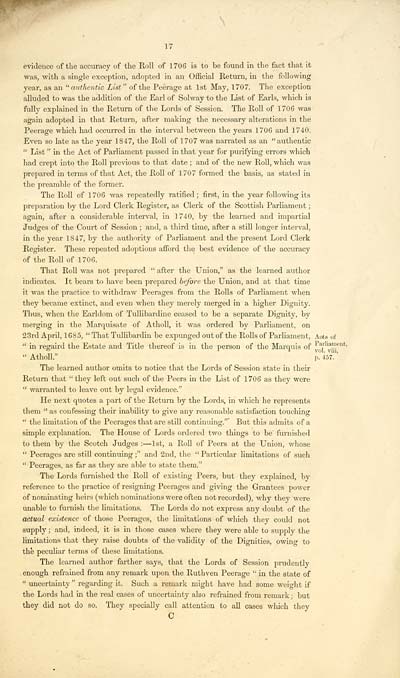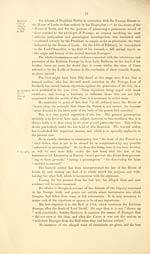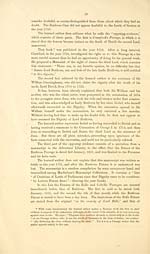Memorial as to the Ruthven peerage
(21) Page 17
Download files
Complete book:
Individual page:
Thumbnail gallery: Grid view | List view

17
evidence of the accuracy of the Roll of 1706 is to be found in the fact that it
was, with a single exception, adopted in an Official Return, in the following
year, as an "authentic List" of the Peerage at 1st May, 1707. The exception
alluded to was the addition of the Earl of Solway to the List of Earls, which is
fully explained in the Return of the Lords of Session. The Roll of 1706 was
again adopted in that Return, after making the necessary alterations in the
Peerage which had occurred in the interval between the years 1706 and 1740.
Even so late as the year 1847, the Roll of 1707 was narrated as an "authentic
" List " in the Act of Parliament passed in that year for purifying errors which
had crept into the Roll previous to that date ; and of the new Roll, which was
prepared in terms of that Act, the Roll of 1707 formed the basis, as stated in
the preamble of the former.
The Roll of 1706 was repeatedly ratified; first, in the year following its
preparation by the Lord Clerk Register, as Clerk of the Scottish Parliament ;
again, after a considerable interval, in ] 740, by the learned and impartial
Judges of the Court of Session ; and, a third time, after a still longer interval,
in the year 1847, by the authority of Parliament and the present Lord Clerk
Register. These repeated adoptions afford the best evidence of the accuracy
of the Roll of 1706.
That Roll was not prepared " after the Union," as the learned author
indicates. It bears to have been prepared before the Union, and at that time
it was the practice to withdraw Peerages from the Rolls of Parliament when
they became extinct, and even when they merely merged in a higher Dignity.
Thus, when the Earldom of Tullibardine ceased to be a separate Dignity, by
merging in the Marquisate of Atholl, it was ordered by Parliament, on
23rd April, 1685, " That Tullibardin be expunged out of the Rolls of Parliament, Aots of
" in regaird the Estate and Title thereof is in the person of the Marquis of " arIia ™ en *>
" Atholl." P°457 n '
The learned author omits to notice that the Lords of Session state in their
Return that "they left out such of the Peers in the List of 1706 as they were
" warranted to leave out by legal evidence."
He next quotes a part of the Return by the Lords, in which he represents
them " as confessing their inability to give any reasonable satisfaction touching
" the limitation of the Peerages that are still continuing."' But this admits of a
simple explanation. The House of Lords ordered two things to be furnished
to them by the Scotch Judges : — 1st, a Roll of Peers at the Union, whose
" Peerages are still continuing ;" and 2nd, the " Particular limitations of such
" Peerages, as far as they are able to state them."
The Lords furnished the Roll of existing Peers, but they explained, by
reference to the practice of resigning Peerages and giving the Grantees power
of nominating heirs (which nominations were often not recorded), why they were
unable to furnish the limitations. The Lords do not express any doubt of the
actual existence of those Peerages, the limitations of which they could not
supply ; and, indeed, it is in those cases where they were able to supply the
limitations that they raise doubts of the validity of the Dignities, owing to
the peculiar terms of these limitations.
The learned author farther says, that the Lords of Session prudently
enough refrained from any remark upon the Ruthven Peerage " in the state of
" uncertainty" regarding it. Such a remark might have had some weio-ht if
the Lords had in the real cases of uncertainty also refrained from remark; but
they did not do so. They specially call attention to all cases which they
C
evidence of the accuracy of the Roll of 1706 is to be found in the fact that it
was, with a single exception, adopted in an Official Return, in the following
year, as an "authentic List" of the Peerage at 1st May, 1707. The exception
alluded to was the addition of the Earl of Solway to the List of Earls, which is
fully explained in the Return of the Lords of Session. The Roll of 1706 was
again adopted in that Return, after making the necessary alterations in the
Peerage which had occurred in the interval between the years 1706 and 1740.
Even so late as the year 1847, the Roll of 1707 was narrated as an "authentic
" List " in the Act of Parliament passed in that year for purifying errors which
had crept into the Roll previous to that date ; and of the new Roll, which was
prepared in terms of that Act, the Roll of 1707 formed the basis, as stated in
the preamble of the former.
The Roll of 1706 was repeatedly ratified; first, in the year following its
preparation by the Lord Clerk Register, as Clerk of the Scottish Parliament ;
again, after a considerable interval, in ] 740, by the learned and impartial
Judges of the Court of Session ; and, a third time, after a still longer interval,
in the year 1847, by the authority of Parliament and the present Lord Clerk
Register. These repeated adoptions afford the best evidence of the accuracy
of the Roll of 1706.
That Roll was not prepared " after the Union," as the learned author
indicates. It bears to have been prepared before the Union, and at that time
it was the practice to withdraw Peerages from the Rolls of Parliament when
they became extinct, and even when they merely merged in a higher Dignity.
Thus, when the Earldom of Tullibardine ceased to be a separate Dignity, by
merging in the Marquisate of Atholl, it was ordered by Parliament, on
23rd April, 1685, " That Tullibardin be expunged out of the Rolls of Parliament, Aots of
" in regaird the Estate and Title thereof is in the person of the Marquis of " arIia ™ en *>
" Atholl." P°457 n '
The learned author omits to notice that the Lords of Session state in their
Return that "they left out such of the Peers in the List of 1706 as they were
" warranted to leave out by legal evidence."
He next quotes a part of the Return by the Lords, in which he represents
them " as confessing their inability to give any reasonable satisfaction touching
" the limitation of the Peerages that are still continuing."' But this admits of a
simple explanation. The House of Lords ordered two things to be furnished
to them by the Scotch Judges : — 1st, a Roll of Peers at the Union, whose
" Peerages are still continuing ;" and 2nd, the " Particular limitations of such
" Peerages, as far as they are able to state them."
The Lords furnished the Roll of existing Peers, but they explained, by
reference to the practice of resigning Peerages and giving the Grantees power
of nominating heirs (which nominations were often not recorded), why they were
unable to furnish the limitations. The Lords do not express any doubt of the
actual existence of those Peerages, the limitations of which they could not
supply ; and, indeed, it is in those cases where they were able to supply the
limitations that they raise doubts of the validity of the Dignities, owing to
the peculiar terms of these limitations.
The learned author farther says, that the Lords of Session prudently
enough refrained from any remark upon the Ruthven Peerage " in the state of
" uncertainty" regarding it. Such a remark might have had some weio-ht if
the Lords had in the real cases of uncertainty also refrained from remark; but
they did not do so. They specially call attention to all cases which they
C
Set display mode to:
![]() Universal Viewer |
Universal Viewer | ![]() Mirador |
Large image | Transcription
Mirador |
Large image | Transcription
Images and transcriptions on this page, including medium image downloads, may be used under the Creative Commons Attribution 4.0 International Licence unless otherwise stated. ![]()
| Histories of Scottish families > Memorial as to the Ruthven peerage > (21) Page 17 |
|---|
| Permanent URL | https://digital.nls.uk/95642683 |
|---|
| Description | A selection of almost 400 printed items relating to the history of Scottish families, mostly dating from the 19th and early 20th centuries. Includes memoirs, genealogies and clan histories, with a few produced by emigrant families. The earliest family history goes back to AD 916. |
|---|

